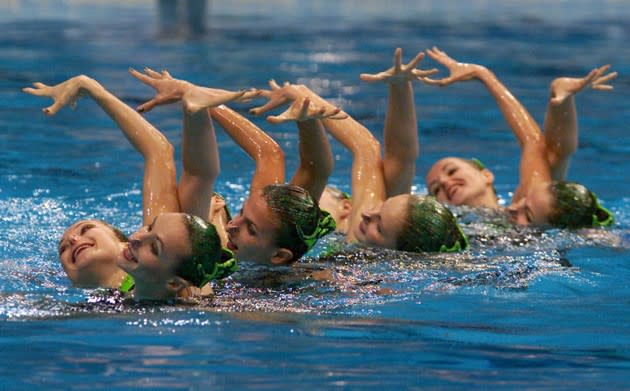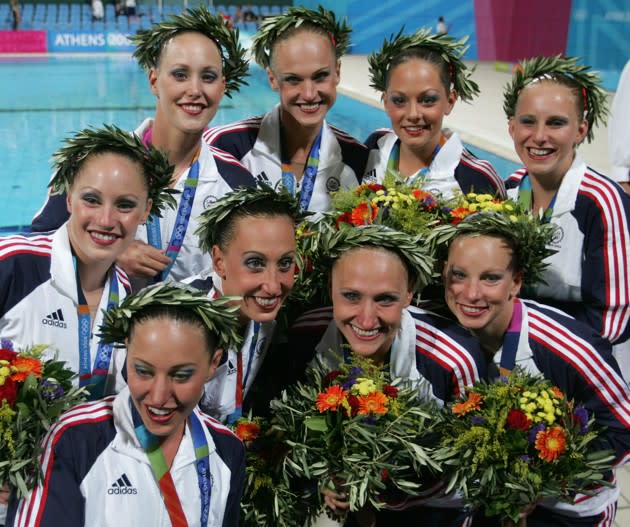Why Isn’t There a U.S. Synchronized Swimming Team in Rio?
Karensa Tjoa didn’t have Olympic ambitions in 2006 when she first joined the Santa Clara Aquamaids, the most elite synchronized-swimming club in the United States. “To be honest I didn’t have much talent at the beginning,” she told me, but the team’s head coach Chris Carver, also a longtime Olympic coach, thought otherwise and took Tjoa under her wing. Tjoa’s ambitions grew, and at the age of 15 she opted to trade high school for a combination of online classes and homeschooling so she could spend more time training. She called the decision the “tipping point” that helped her make the U.S. Senior National Synchronized Swimming Team.
Over the next year, Tjoa trained for up to 10 hours a day while wrangling a freshman course load at U.C. Berkeley. After a semester of being pulled in two directions, she decided to take some time off from college. Then, in 2015 she received an email from USA Synchro, the governing body of the sport in the United States, letting her know they wouldn’t be sending a team to the Olympic qualifiers in Rio de Janeiro in 2016. The short reason? Not enough athletes. The long reason? It’s complicated.
Recommended: What Happened to the U.S. Olympic Swimmers in Rio?
The United States, where competitive synchronized swimming was born, once completely dominated the sport. But over the past decade and a half, America has fallen far behind in international rankings, failing to send a team to Rio this year or to the London Games in 2012 (though the U.S. has sent duet pairs both times). Meanwhile, Russia has won every Olympic gold medal in synchronized swimming in the 21st century. And, after coming in first in the technical team routine this week, the country looks prepared to win another one after the final event on Friday. The reasons for this reversal include a perfect storm of overlapping factors—cultural differences around athlete training, funding challenges that make it difficult to retain top American athletes, and an outdated international scoring system that locks countries into semi-permanent rankings.
Even the Olympic qualifiers process, which doesn’t always ensure that the world's best teams are represented at the games, has worked against the U.S. And the athletes are caught in the middle. “I think before it used to be about whether you were good enough to make the team,” says Tjoa. “It was all about how hard you worked, and it was sort of about the individual, and now there are so many things that are out of our control as athletes.”
To fully grasp the significance of America’s decline in synchro, it’s important to understand not only that the U.S. once ruled the sport, but also that synchronized swimming as we know it today was nurtured into existence, survived its awkward growing years, and eventually made its Olympic debut all on America soil. The first synchronized-swimming competition was held at the Chicago’s Teachers College in 1939 under the direction of Katharine Curtis, a physical-education instructor who also wrote the sport’s first rulebook. American and Canadian proponents of synchronized swimming spearheaded goodwill exhibitions and coaching clinics that helped the sport spread around the globe and eventually gain Olympic acceptance.
And when synchronized swimming made its Olympic debut in the 1984 Summer Games in Los Angeles, it was the Americans Tracie Ruiz and Candy Costie who won the gold for the duet, the only synchro event that first year. In the Atlanta Games of 1996, the U.S. again made history, winning the first gold medal for the newly inaugurated team event (the duet event was taken off the program in 1996 but returned four years later).
Recommended: 'Kubo and the Two Strings' Is a Gorgeous Stop-Motion Adventure
After 1996, however, the entire American synchronized-swimming team retired, and USA Synchro faced the task of rebuilding its national program. At the same time, the competition abroad was becoming more seasoned. “I think after 1996 when we won, everybody just kind of got serious with their programs,” says Shari Darst, the education director at USA Synchro. As a result, the 2000 Olympics in Sydney proved to be a total game-changer. For the first time in the sport’s Olympic history, the U.S. failed to bring home a single medal, while Russia won its first two—both gold. The trend has continued, with Russia winning every Olympic gold medal since, while the last medals the United States won were two bronzes in 2004.
In the U.S., Olympic sports receive their funding allotment from the non-governmental U.S. Olympic Committee (USOC) according to past performance. Dubbed “money for medals,” the system doles out the most support to sports winning the most medals, and reduces funding for those that come home empty-handed. With only two medal events per Olympiad, synchronized swimming is at a disadvantage compared with sports like swimming, gymnastics, and track and field with numerous events, and thus far more medal opportunities. That, combined with the sport’s failure to medal in the last two Olympiads, has resulted in the USOC cutting its 2015 funding for synchronized swimming to the lowest point it’s been in at least 17 years.

Even so, the U.S. team is up against countries like Russia, China, and even Italy, where the government provides extensive support for its national sports programs. Russian synchronized swimmers training at the national level, for example, earn comfortable salaries—plus generous performance-based cash awards and valuable prizes like cars—that allow them to stay in the sport long enough to participate in multiple Olympiads.
Recommended: The Gorgeous Mysteries of Frank Ocean's 'Endless'
The synchro swimmers and officials I spoke with told me that, in addition to being able to participate longer, Russian and Chinese athletes start much younger, with kids who show promise moving away from their families to train under professional coaches with other aspirants. By the time they’re old enough to be on the national team, these swimmers have already been training and competing together for years. In the United States, cultural views on what is appropriate for child athletes make this sort of intensive, live-in training for youth virtually an impossibility.
Unhampered by funding crises or such cultural restrictions, Russia has eclipsed the U.S. The “Katie Ledecky” of synchronized swimming, Russia is laps ahead of the competition. “Right now, everybody is just trying to keep up,” says Darst of the Russian team. “Whenever you think you’re getting close to them, they always find something else to do that’s even more amazing.”
Although Russia’s spot is virtually uncontested—for now at least—for many other teams around the world, their own global rankings, whether 5th, 8th, or 13th, have long felt just as immovable. The slightest change in rank sometimes takes years, making it seem as though teams are being judged on past reputation rather than current performance. The continental representation system, in which each continent gets to send one team, as determined by regional championships (though the Olympic host country automatically takes the slot for its continent), further frustrates things. Since there are only eight Olympic slots available for the synchronized-swimming team event, and five of those are taken up by the continental teams, that leaves only three spots for the rest of the world to compete for at the Olympic qualifiers.
The U.S. team came in 12th for their free routine at the last FINA world championships, leaving little chance of earning one of the three Olympic spots (and then soon after, it lost two athletes to injury and college). As a result, it just didn’t make sense to spend already limited funds on replenishing, training, and sending a team to the qualifiers in Rio this spring. Instead, the U.S. put all its hope on this year’s American duet pair, Mariya Koroleva and Anita Alvarez, who came in ninth earlier this week in Rio, and began looking forward.
And things appear hopeful. There are international efforts under way to improve the way routines are scored and to add two more competitive slots for the Olympic team event, says Virginia Jasontek, the honorary secretary to the FINA Technical Synchronized Swimming Committee. In an effort to make the rankings less “locked-in,” some have proposed moving to a starting point/deduction-based system similar to what’s used in gymnastics. In addition, FINA has already added a third panel of judges, one for each of the synchro scoring categories—difficulty, artistic impression, and execution—each with specific instructions on what to watch for. “We want to make sure the judges are judging what they see in the water that day,” says Jasontek, rather than coming in with predetermined ideas about how a team will perform.

It seems to be working. In an interview earlier this week, Koroleva said of her ninth-place ranking with partner Alvarez, “It’s definitely our highest score ever, by a lot. In the last year we’ve moved up three spots, which is kind of unheard of in synchro, to do that.” In addition to these improvements in scoring, if efforts to add two new slots in the team event succeed, that would go a long way in motivating athletes. “I think that would put the qualifiers within reach, I really do,” says Carver. “We’re behind, but that would give us a lot more incentive. And incentive is what keeps people going.” Tjoa, who resumed her studies after learning that the U.S. wouldn’t be training a team for the qualifiers, says she’d consider coming back if two new spots are added. “If that happened, it would be more up to the athletes and their ability to work hard,” she says. “We’d feel more in control of the situation.”
In addition to these international efforts, there’s a lot of work going on at home. USA Synchro has launched a number of efforts to be more inclusive of athletes of all skill levels, as well as to provide better training and more competitive opportunities for athletes who want to pursue the sport at a serious level, such as a national talent program and intensive training camps each summer. “We are training them not just as synchronized swimmers but as well-rounded athletes,” says Darst, “concentrating not only on what they do in the water but adding in other aspects such as acrobatics, flexibility, and strength training.”
The organization is working hard to build participation in the 12-and-under age group—the future of the sport—as well as trying to bring the junior national team together earlier and more often for team training. But since they’ll never start intensive training as young or frequently as in some countries, USA Synchro has also started several initiatives to provide coaches with tools and training that are more consistent across the country so that swimmers will be building the same skill sets.
Thanks to these efforts, there are now two national teams for each age group, and the 2015 summer talent camps had double the number of participants as last year’s. Judy McGowan, the president of USA Synchro, also points to the performance of American youth at the 2015 UANA Pan-American Synchronized Swimming championships between 13 nations, where the U.S. won the most overall points in every age group. “We have a number of really good, young kids coming up, which is a positive. We just need to keep them involved in the sport through the higher level,” says McGowan.
Tjoa still sees the chance for a comeback. “I think the U.S. is most known for our American spirit and pride, determination and fight, and I do still think [synchronized swimming] could be our thing,” she says. Carver, too, is optimistic, but acknowledges the team has plenty of work ahead. “Things have changed and we do have challenges.” she says. “That doesn’t mean we can’t overcome them, but it’s going to take a long time.”
Read more from The Atlantic:
This article was originally published on The Atlantic.
